As an Amazon Associate, we earn from qualifying purchases with no additional costs for you.
Most people know what a bread knife is and what it looks like, and many people who do not understand its use may consider it redundant in the kitchen. What other uses does the bread knife have in the kitchen, and what is it not suitable for cutting?
Bread knives can cut items with a tough skin but a soft interior, such as ripe tomatoes, citrus fruit, pineapples, and melons. Tough cuts of cooked meat such as brisket are easily sliced. Bread knives can sculpt and slice cakes. Raw meat and meat with bones are not for these knives.
A bread knife is a relatively long kitchen knife with a serrated edge. It does an excellent job of slicing various types of bread, but what other slicing tasks can you perform with this knife? You may be surprised at the knife’s versatility and what this blade is capable of doing for you in the kitchen!
If you are looking for a high-quality bread knife that is reliable and easy to effective, check out our recommendation here (Amazon link)
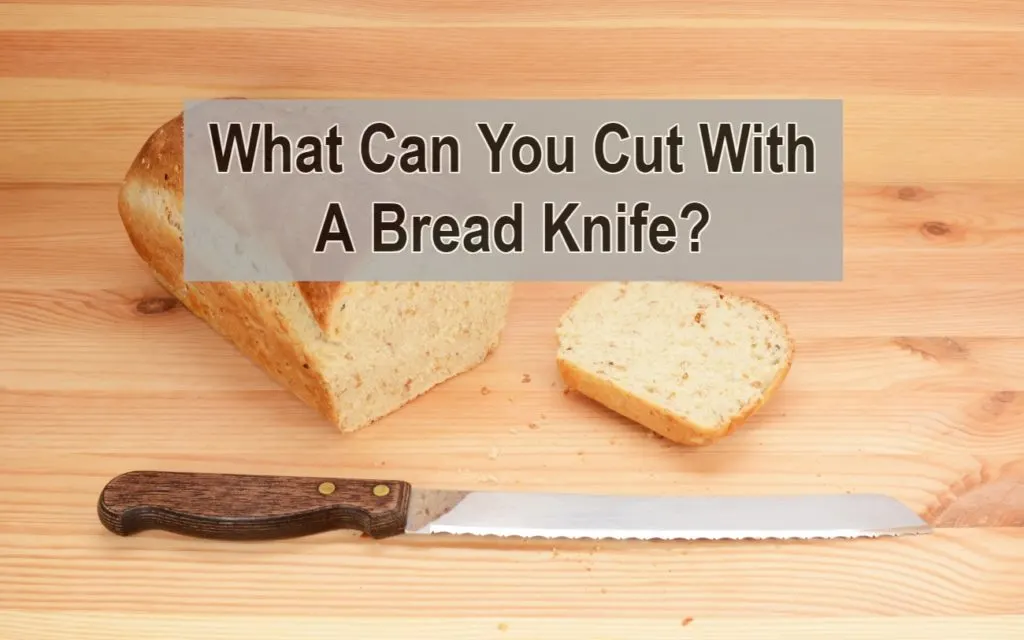
If you are interested in checking out the best serrated knife made by the Wusthof company you can find it by clicking here (Amazon link).
What Can You Cut With A Bread Knife?
A bread knife may seem to be a limited function knife in most kitchens if it is only used to cut bread! Many people would think twice about buying a bread knife it slicing bread is the limit of its use in the kitchen.
A bread knife is a serrated knife, where the serrations are evenly sized and evenly spaced. The symmetric design of the serrations has led to this knife being referred to as having a scalloped blade. What are the advantages of the blade design on a bread knife, and is its use limited to bread alone?
Serrated blades are better at cutting tough, fibrous material than a straight edge blade. Serrated knives stay sharper for longer and consequently require less frequent sharpening. However, they are more difficult to sharpen than a straight edge blade.
The peaks or teeth on a serrated edge blade contact the food item first, placing greater pressure on a small area, allowing the point to pierce the tough surface and begin the cut. The secondary cut is made by the curved inner portion of the serration.
This feature makes serrated knives perfect for cutting bread with hard crusts. Less pressure is required to pierce the hard crust, which prevents the bread from being crushed while being cut.
The disadvantage of a serrated edge on a knife is that the cut is not as clean or precise as that of a straight-edge blade.
Can You Use a Bread Knife to Cut Meat?
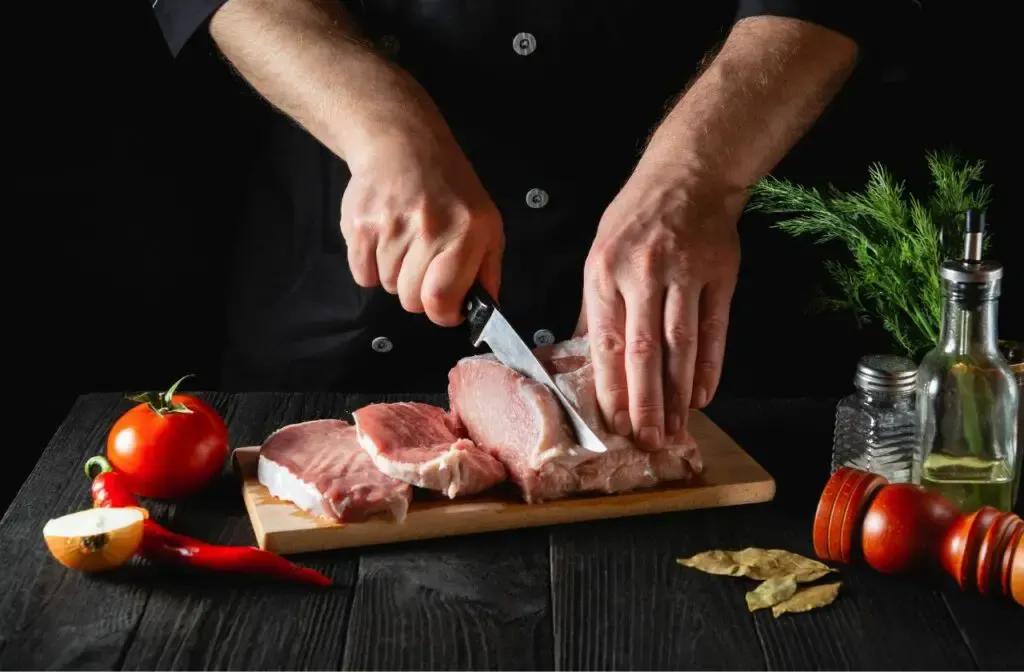
A bread knife makes an excellent slicing knife for meat, especially tougher cuts of meat. The superior ability of the serrated blade to cut through tough, fibrous material makes it a knife suitable to cut meat with lots of connective tissue or sinew embedded in the meat.
The sawing motion used with a bread knife allows the teeth of the serrations to pierce the tough areas with relatively little pressure, and the forward motion of the slice allows the scalloped curves to make micro-cuts into the meat.
This makes a bread knife more effective for cutting tough pieces of meat than a straight-edge knife. You will find that for this reason, a bread knife makes a great choice for cutting a sandwich that has meat inside. The serrations help to cut the bread without squashing it and also easily cut through the meat inside the sandwich.
Can You Use A Bread Knife To Cut Tomatoes?
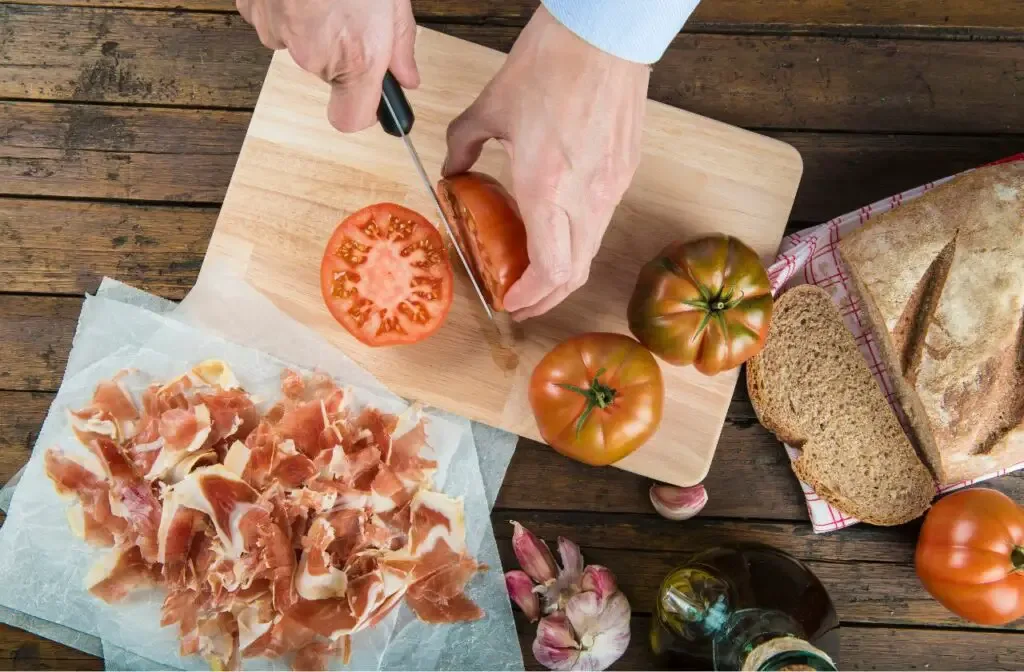
A bread knife does a great job of cutting tomatoes, especially large tomato varieties. Small tomatoes may be too small to safely hold and cut with a serrated knife since serrated knives do not have the same precision in the cut as a straight blade.
Serrated blades work well to cut ripe tomatoes that have started going soft because less pressure is required to make the cut.
Bread knives are not only good for cutting tomatoes but also make quick work of oranges, lemons, and pineapple without squeezing all the juice out of the fruit.
Tough-skinned vegetables and fruit such as butternut squash, pumpkins, and melons are difficult to cut with straight edge knives because the hard skin pinches the blade. The serrations on a bread knife are not trapped in the hard skin and consequently cut through these tough ingredients easier.
TIP: If you are looking for Japanese kitchen knives to chop and process vegetables, then you have many you can choose from. Check out the best Japanese knives for vegetables in the article below:
The 8 Best Japanese Knives For Chopping Vegetables
Can You Use a Bread Knife to Cut Cake?
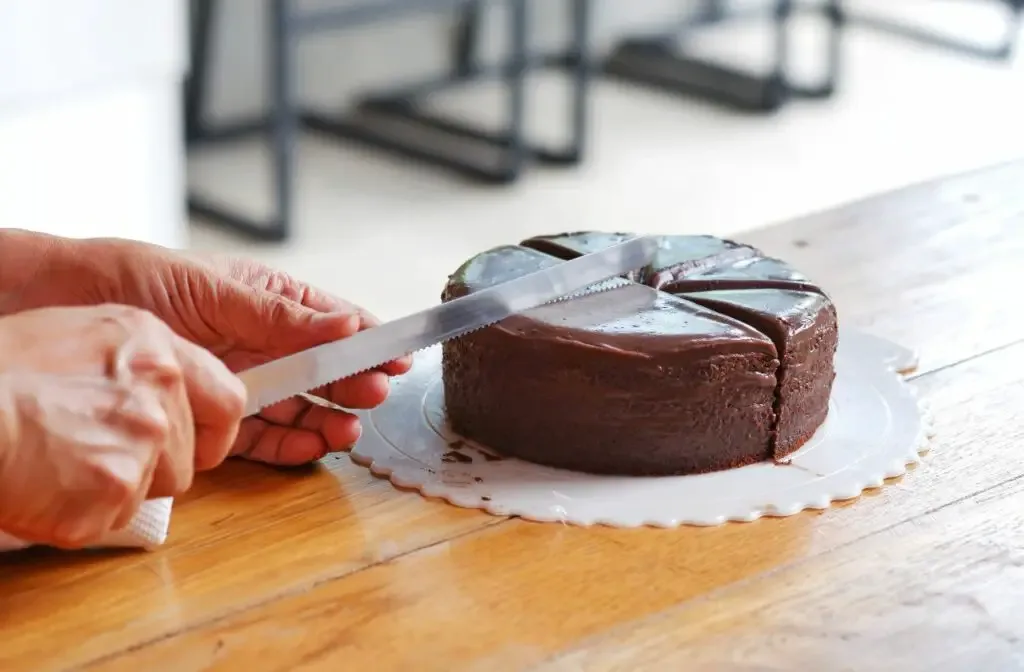
A bread knife is a favored tool among bakers for several reasons! One of the most popular baking uses for a bread knife is sculpting cakes. The long blade combined with the lower pressure needed in the cut makes them ideal for shaping a cake prior to applying the icing.
A straight-edge knife does not easily slice through the spongy, delicate texture of a cake and compresses the cake as it tries to push through the soft material. The cake’s soft material and sticky texture also cause suction against the straight edge, resulting in chunks of cake being pulled loose from inside the cake.
The serrations on a bread knife blade break this suction of the soft, moist cake on the blade, allowing the knife to pass through without damaging the cake. This makes for a cleaner, more presentable slice of cake.
The length of a bread knife also allows the knife to cut completely through the entire cake with one pass.
Can You Use A Bread Knife To Cut Brisket?
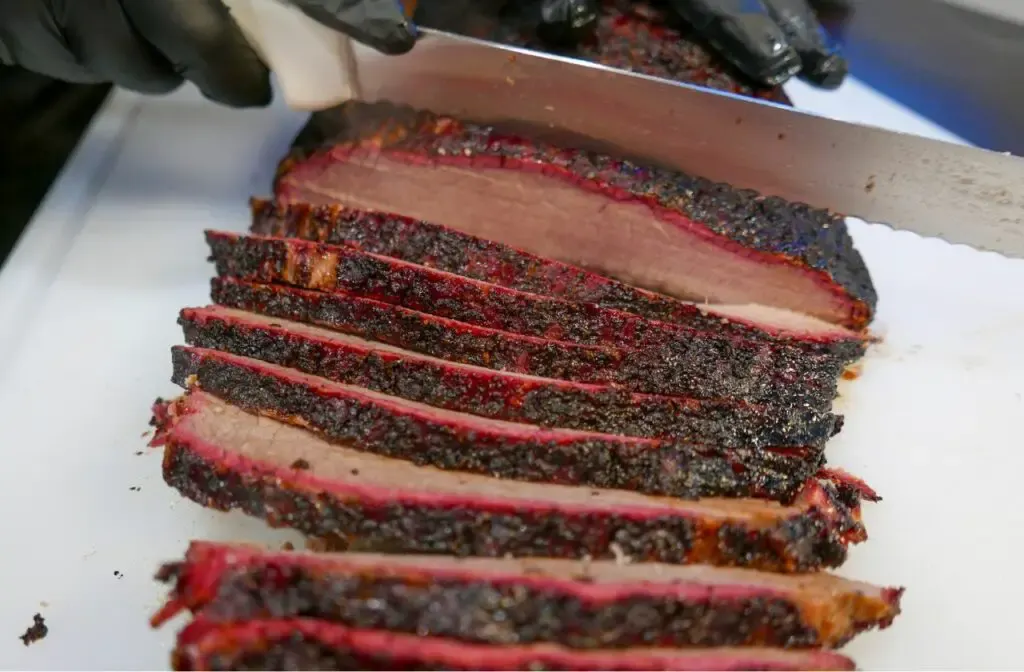
Brisket is a very popular cut of meat for smoking and grilling, especially when using the slow and low method. The slow and low method of cooking brisket is necessary because it is traditionally a cheaper, tougher cut of meat.
The long cook time helps to break down the connective tissue in the meat and make it as tender as possible. However, as any backyard smoker will tell you, slicing the brisket correctly is just as important to produce tender brisket on the plate.
This is where a good bread knife makes the perfect tool for slicing your perfectly smoked brisket! The serrations on the bread knife blade cut easily through the connective tissue in the meat that has been softened by the cooking process.
Remember to always cut your brisket against the grain of the meat to minimize the amount of connective tissue in each bite. This will enhance the tenderness of the brisket in the mouth of your guests!
TIP: When people start sharpening their own knives, they find that some knives are hard to sharpen. Check out why some knives are hard to sharpen in the article below:
5 Reasons Why Some Knives Are Hard To Sharpen & What To Do
What Should You Not Cut With a Bread (Serrated) Knife
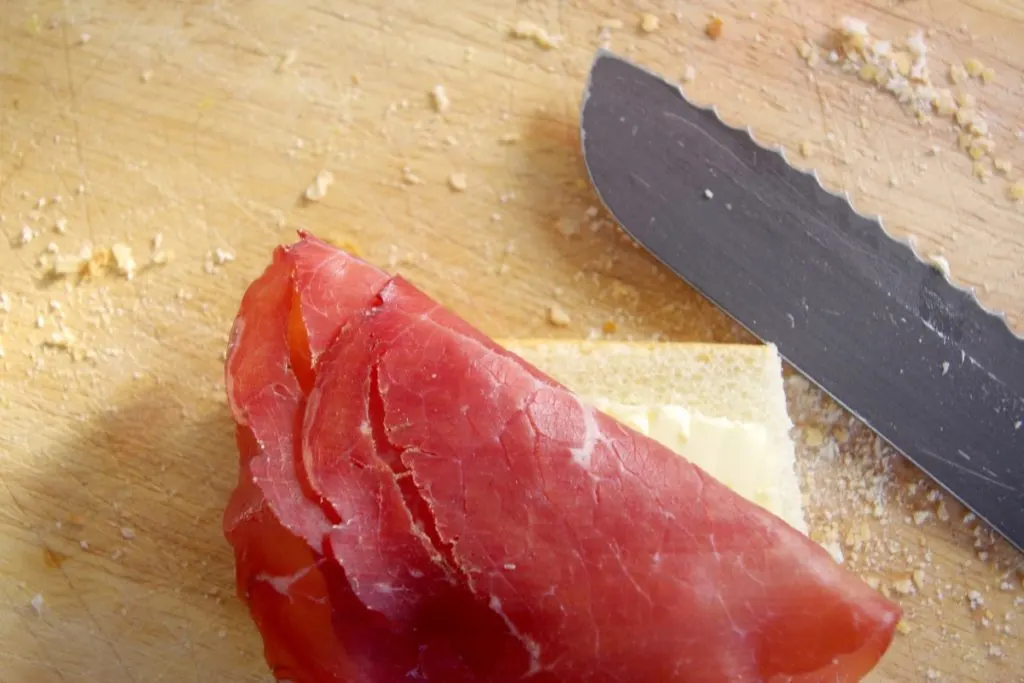
We have covered several items you can cut with your versatile bread knife, but there are certain things you should avoid cutting with these knives.
- Do not use a hard cutting board.
Cutting on a hard metal, metal, or glass cutting board will not be doing your bread knife any favors. The hard surface will dull the sharp points on the serrations and damage the edge. A wood cutting board is best paired with a bread knife.
- Meat with the bone in.
Do not cut meat with the bone in with your serrated knife. When the knife comes into contact with the bone inside the meat, the sawing action used with these knives will dull multiple serrations along the length of the knife, effectively dulling the edge.
- Raw meat.
Serrated knives do not work well on raw meat due to the sawing motion required to make the cut. A straight edge knife will outperform a serrated knife on raw meat. A serrated blade will also hook on the fibers of raw meat and rip the meat rather than cutting through it.
TIP: Are you looking to buy a new whetstone? Check out our recommendations (we personally use the first three ones):
Our PRO choice whetstones combo (Amazon links):
- Fixing stone: Whetstone SHAPTON Ceramic KUROMAKU #320
- Sharpening stone: Suehiro CERAX soaking whetstone: Medium #1000
- Finishing stone: Whetstone SHAPTON Ceramic KUROMAKU #5000
Our budget choice (Amazon link): Sharp Pebble Extra Large Sharpening Stone Set
Comparison: Bread Knives vs. Other Types of Knives
While the bread knife is an indispensable tool for slicing bread and certain fruits, it’s essential to recognize the specialized nature of other knives. Each knife type shines in its designated tasks, ensuring efficiency and precision in the kitchen.
By understanding the strengths of each knife, you can make informed decisions about which one to use for specific ingredients and dishes.
Each type of kitchen knife has been designed with specific tasks in mind. The bread knife, with its serrated edge, is no exception. Let’s compare bread knives and other common kitchen knives to understand their unique strengths and optimal uses.
Bread Knife (Serrated Knife) vs. Chef’s Knife:
Bread Knife: Best for slicing foods with a tough exterior and soft interior, such as bread, tomatoes, and citrus fruits. The serrated edge allows for a sawing motion, making it easier to cut without crushing the food.
Chef’s Knife: A versatile all-purpose knife, ideal for chopping, dicing, and mincing vegetables, herbs, and meats. Its broad and sharp blade can handle most kitchen tasks but may crush soft bread or delicate pastries.
Bread Knife vs. Paring Knife:
Bread Knife: Excellent for slicing larger foods, especially those with contrasting textures.
Paring Knife: A small knife designed for precise tasks like peeling, trimming, and slicing small fruits and vegetables. It’s not suitable for slicing bread or large fruits but excels in detailed work.
Bread Knife vs. Carving Knife:
Bread Knife: While it can slice meats, especially those with tougher exteriors, it’s primarily designed for bread and soft fruits.
Carving Knife: A long, thin knife designed specifically for slicing thin cuts of meat. It’s perfect for carving roasts, hams, and poultry, providing clean and even slices.
Bread Knife vs. Santoku Knife:
Bread Knife: The serrated edge is its defining feature, making it unique in its cutting approach.
Santoku Knife: A Japanese all-purpose knife, similar to a chef’s knife but with a shorter, flatter blade. It’s great for slicing, dicing, and chopping but lacks the serrated edge needed for crusty bread.
Bread Knife vs. Fillet Knife:
Bread Knife: Not designed for precision tasks but rather for sawing through tough exteriors.
Fillet Knife: A thin, flexible blade designed for filleting fish. It allows for precision when separating fish flesh from bones and skin.
Conclusion
A bread knife or serrated knife is more versatile in the kitchen than you may think. Next time you need to trim or slice a cake, cut large ripe tomatoes, citrus fruit, melons or pineapples, or your freshly smoked brisket, try using your bread knife.
The result may surprise you and result in new-found uses for your bread knife that spends most of its time unused and tucked away at the back of your kitchen drawer!
If you are interested in checking out the best serrated knife made by the Wusthof company you can find it by clicking here (Amazon link).
TIP: The serrated edge is a challenge when it comes to sharpening the knife. Check out the best sharpeners for serrated knives in the article below:
TOP 7 Knife Sharpeners For Serrated Knives: Complete Guide

